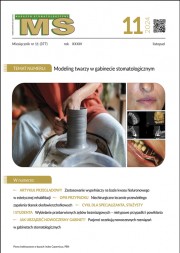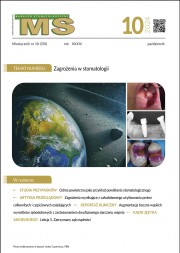Dostęp do tego artykułu jest płatny.
Zapraszamy do zakupu!
Po dokonaniu zakupu artykuł w postaci pliku PDF prześlemy bezpośrednio pod twój adres e-mail.
STUDIUM PRZYPADKU
Chemiczne oparzenia błony śluzowej jamy ustnej - opis przypadku i przegląd piśmiennictwa
Chemical burns of the oral mucosa - a case report and narrative literature review
Agata Dudzik, Jakub Bukowski, Ewa Michalak
Streszczenie
Chemiczne poparzenia błony śluzowej jamy ustnej są dość częste. Objawy kliniczne i następstwa działania środków niebezpiecznych na organizm zależą od: rodzaju substancji, jej stężenia, ilości, pH, czasu ekspozycji. Zmianami są obejmowane różne obszary jamy ustnej. Poparzenia mogą być wywołane przez leki, substancje naturalne, składniki płukanek czy past do zębów, a także środki chemiczne połknięte omyłkowo bądź specjalnie (próby samobójcze). W tej pracy opisano przypadek chemicznego oparzenia błony śluzowej jamy ustnej spowodowanego przez środek do udrażniania rur.
Abstract
Chemical burns of the oral mucosa are quite common. The clinical symptoms and consequences of exposure to hazardous substances on the body depend on the type of substance, its concentration, quantity, pH, and duration of exposure. Alterations may be seen in different regions within the oral cavity. Chemical burns can be caused by medications, natural substances, ingredients in mouthwashes or toothpaste, as well as chemicals accidentally or intentionally ingested (suicidal attempts). This study describes a case of chemical burn of the oral mucosa caused by a pipe-clearing agent.
Hasła indeksowe: błona śluzowa, oparzenie chemiczne
Key words: oral mucosa, chemical burn
Piśmiennictwo
- Działanie wysokiej temperatury i zatrucia wziewne. W: Chomoncik M, Nitecki J, Poprada W. Kwalifikowana pierwsza pomoc w KSRG. Wydawnictwo PZWL; 2018, s. 219-228.
- Niedzielski A, Schwartz SG, Partycka-Pietrzyk K i wsp. Caustic agents ingestion in children. A 51-year retrospective cohort study. Ear Nose Throat J. 2020; 99(1): 52-57.
- Mielnik-Niedzielska G. Zatrucia środkami żrącymi. W: Szajner-Milart I, Wójcik-Skierucha E (red.). Ostre zatrucia u dzieci. Zasady postępowania. Warszawa-Boston: Wydawnictwo Lekarskie PZWL; 2000.
- Vargo RJ, Warner BM, Potluri A i wsp. Garlic burn of the oral mucosa. A case report and review of self-treatment chemical burns. J Am Dent Assoc. 2017; 148(10): 767-771.
- Antunes LA, Kuchler EC, de Andrade Risso P i wsp. Oral chemical burns caused by self-medication in a child. Case report. J Burn Care Res. 2009; 30(4): 740-743.
- Bharath Kumar C, Chowdhury SD, Ghatak SK i wsp. Immediate and long-term outcome of corrosive ingestion. Indian J Gastroenterol. 2019; 38(4): 356-361.
- Cowan T, Foster R, Isbister GK. Acute esophageal injury and strictures following corrosive ingestions in a 27year cohort. Am J Emerg Med. 2017; 35(3): 488-492.
- Arévalo-Silva C, Eliashar R, Wohlgelernter J i wsp. Ingestion of caustic substances. A 15-year experience. Laryngoscope. 2006; 116(8): 1422-1426.
- Gilvetti C, Porter SR, Fedele S. Traumatic chemical oral ulceration. A case report and review of the literature. Br Dent J. 2010; 208(7): 297-300.
- Hagiwara Y, Seki K, Takahashi Y. Oral chemical burn due to accidental ingestion of calcium oxide food desiccant in a patient with dementia. J Int Med Res. 2020; 48(4): 300060520920065.
- Yeroshalmi F, Sidoti EJ Jr, Adamo AK i wsp. Oral electrical burns in children – a model of multidisciplinary care. J Burn Care Res. 2011; 32(2): e25-e30.
- Chae HS, Kang S. Oral chemical burns caused by topical application of policresulen. A case report. J Yeungnam Med Sci. 2023; 40(3): 293-296.
- Guggenheimer J, Barket SJ, Bilodeau EA. A white lesion of the buccal mucosa. J Am Dent Assoc. 2014; 145(9): 961-963.
- Dayakar MM, Pai PG, Madhavan SS. “Tetracycline hydrochloride chemical burn” as self-inflicted mucogingival injury. A rare case report. J Indian Soc Periodontol. 2012; 16(2): 282-285.
- Rostami AM, Brooks JK. Intraoral chemical burn from use of 3% hydrogen peroxide. Gen Dent. 2011; 59(6): 504-506.
- Touyz LZ, Hille JJ. A fruit-mouthwash chemical burn. Report of a case. Oral Surg Oral Med Oral Pathol. 1984; 58(3): 290-292.
- Ribeiro AC, Simonato LE, Santos-Silva AR i wsp. Formalin burn. Br Dent J. 2010; 209(1): 4.
- Kang S, Kufta K, Sollecito TP i wsp. A treatment algorithm for the management of intraoral burns. A narrative review. Burns. 2018; 44(5): 1065-1076.
- Cancio LC, Sheridan RL, Dent R i wsp. Guidelines for burn care under austere conditions. Special etiologies. Blast, radiation, and chemical injuries. J Burn Care Res. 2017; 38(1): e482-e496.
- McKinney R, Olmo H. Physical and chemical lesions of the oral mucosa. 2023. In: StatPearls [Internet]. Treasure Island (FL): StatPearls Publishing.














